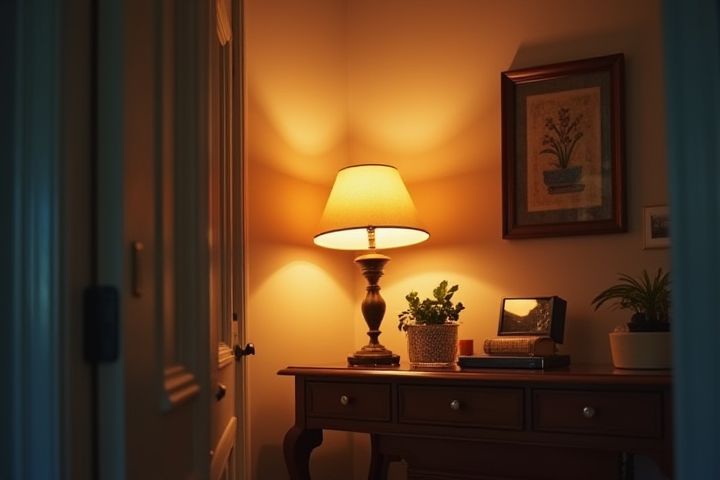
House lighting significantly impacts mood by influencing both psychological and physiological responses. Bright, natural light can enhance your energy levels, motivation, and alertness, making it ideal for workspaces. In contrast, soft and warm lighting creates a cozy atmosphere that promotes relaxation and comfort, perfect for bedrooms and living areas. Color temperature also plays a vital role; cooler tones can stimulate productivity while warmer hues encourage calmness. By carefully selecting lighting fixtures and bulbs, you can tailor your home's ambiance to support the desired emotional state and well-being.
Why House Lighting Affects Mood
Natural light exposure
Natural light exposure significantly enhances your mood and cognitive function by influencing the body's circadian rhythm, which regulates sleep patterns and alertness. Studies have shown that increased exposure to daylight can elevate serotonin levels, a neurotransmitter linked to feelings of well-being, making you feel happier and more energized. Furthermore, workplaces with ample windows allowing natural light can boost productivity by up to 15%, fostering a more focused and creative environment. Recognizing the importance of sunlight can empower you to optimize your living and working spaces for better mental health and performance.
Light color temperature
Light color temperature, measured in Kelvin (K), significantly influences mood and productivity. Cooler colors, typically ranging from 5000K to 6500K, evoke a sense of alertness and enhance concentration, making them ideal for workspaces. In contrast, warmer colors, between 2700K and 3000K, create a cozy, relaxed atmosphere, promoting comfort and social interaction. Your choice of lighting can effectively shape emotional responses, impacting everything from stress levels to creativity throughout your living or working environment.
Intensity of lighting
Intensity of lighting plays a crucial role in influencing mood and mental focus. Bright lighting, typically around 300 to 500 lux, can increase alertness and energy levels, making it ideal for workspaces and study areas. In contrast, softer, dimmer lighting, often below 200 lux, creates a relaxing atmosphere that encourages calmness and unwinding, perfect for living spaces or bedrooms. By adjusting the intensity of your home lighting, you can effectively tailor your environment to enhance productivity or promote relaxation, depending on your needs.
Circadian rhythm alignment
House lighting significantly influences mood by impacting your circadian rhythm, the internal clock that regulates sleep-wake cycles. When you expose yourself to bright, cool light during the day, it can enhance alertness and improve concentration by signaling to your body that it's time to be awake. Conversely, dimming lights in the evening promotes relaxation and facilitates the natural production of melatonin, a hormone crucial for quality sleep. By aligning your lighting with the natural patterns of daylight, you can foster a more balanced mood and optimize your overall well-being.
Mood enhancement capabilities
House lighting significantly impacts mood by influencing emotional well-being and cognitive function. Research indicates that natural light exposure can increase serotonin levels, promoting happiness and reducing feelings of depression. Warm, ambient lights create a cozy atmosphere, enhancing relaxation and comfort, while brighter, cooler lighting can boost alertness and productivity. You can optimize your living space by incorporating a mix of different light sources, such as LED bulbs, to effectively elevate your mood throughout the day.
Impact on sleep quality
The quality of house lighting significantly influences your mood and sleep patterns, with studies revealing that exposure to bright, artificial light in the evening can disrupt circadian rhythms. A study found that 60% of individuals using warm, dim lighting reported improved sleep quality, as opposed to those exposed to harsh fluorescent lights. Properly designed lighting with a color temperature below 3000 Kelvin promotes melatonin production, essential for restful sleep, while cooler tones can hinder it. Creating a balanced light environment in your home can lead to enhanced relaxation, making it easier to wind down and prepare for a good night's sleep.
Energy levels influence
House lighting significantly impacts your mood and energy levels by influencing the body's circadian rhythm. Bright, cool-toned daylight bulbs can enhance alertness and concentration, making them ideal for workspaces or study areas. In contrast, warm, dim lighting promotes relaxation and comfort, perfect for bedrooms or cozy living spaces. Studies indicate that exposure to natural light can boost serotonin levels by up to 50%, directly affecting your overall sense of well-being and mental clarity.
Psychological effects
House lighting plays a crucial role in influencing mood and psychological well-being, with studies indicating that exposure to bright, natural light can enhance serotonin levels and improve overall mood by up to 60%. Conversely, dim lighting can lead to feelings of sadness and lethargy, reducing motivation and productivity by nearly 30%. The color temperature of lights also significantly impacts psychological states; warmer tones create a sense of comfort, while cooler tones can enhance alertness and focus. By strategically using different lighting styles in your home, you can effectively create an environment that promotes happiness and concentration.
Seasonal Affective Disorder
House lighting significantly impacts mood, especially for individuals experiencing Seasonal Affective Disorder (SAD), which affects approximately 5% of the U.S. population. People with SAD may experience symptoms such as depression, fatigue, and irritability during the fall and winter months due to reduced sunlight exposure. Bright light therapy, using light boxes that emit 10,000 lux, has been proven to alleviate these symptoms by mimicking natural sunlight and regulating circadian rhythms. By incorporating bright, warm lighting in your home, you can create a more uplifting environment that fosters improved mental well-being during darker months.
Lighting and relaxation connection
House lighting significantly influences your mood, particularly concerning relaxation. Soft, warm light, such as that emitted by incandescent or LED bulbs with lower Kelvin temperatures (around 2700K), helps create a calming atmosphere that promotes tranquility. In contrast, harsh, bright lighting can lead to increased stress and anxiety, making it challenging to unwind after a long day. Studies suggest that incorporating dimmable lighting options or layers of light, including candles and table lamps, can enhance your ability to relax and improve overall well-being.
